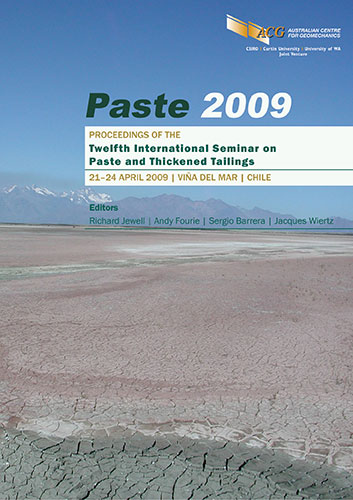Integrated Approach to Water Management

|
Authors: Kuyucak, N; Palkovits, F |
DOI https://doi.org/10.36487/ACG_repo/963_18
Cite As:
Kuyucak, N & Palkovits, F 2009, 'Integrated Approach to Water Management', in R Jewell, AB Fourie, S Barrera & J Wiertz (eds), Paste 2009: Proceedings of the Twelfth International Seminar on Paste and Thickened Tailings, Australian Centre for Geomechanics, Perth, pp. 151-159, https://doi.org/10.36487/ACG_repo/963_18
Abstract:
The increasing regulatory and social demand for the environmentally conscious disposal of mining waste products, the escalating demand of fresh water resources and the disposal of mine and process water back into the environment are some of the key issues affecting mining community and, ultimately, affecting the cost of mining operations. The overwhelming desire to use less process water and to reduce the footprint caused by the disposal of waste materials ranks high on the lists of required actions for mining companies, regulatory agencies, communities and environmental groups. One component of an overall solution which is becoming widely accepted is the use of dewatered tailings which, as part an integrated process approach, returns the surplus water to the mill for re-use. For many processes, this allows immediate recycle of process water hence reduces the amount of impacted water therefore the cost of treating it. It also means that there is less of a need for make-up water. As a result, cost savings can be created in a number of applications around water management including environmental permitting, energy consumption, cost of equipment and water transportation. The integrated approach also considers the sludge by-products from water treatment. In most cases, the sludge is deposited separately from the tailings, waste rock and other waste materials. However, combining these materials may well reduce the geographic footprint of the mine’s waste. A smaller footprint means less area for which a permit must be sought as well as less area that must be monitored during operation and post-closure. This creates flexibility regarding where the waste can be deposited, and reduces operating costs and post-closure liabilities. The paper will discuss advantages of an integrated approach to managing mine wastes and mine water as well as water produced as part of the tailings management process using case studies.
References:
Gunther, P., Mey, W. and van Niekerk, A.M. (2006) Water Reclamation and the drive to sustainability in mining.
Emalahleni, South Africa – Case Study, Water in Mining 2006 Conference, Anglo Coal South Africa, Clewer
1036, South Africa.
Kuyucak, N. and Yaschyshyn, D. (2007) Managing thiosalts in mill effluents studies conducted at the Kidd
metallurgical site. Sudbury 2007, Mining and Environment Conference held in October, 2007 in Sudbury,
Ontario, Canada.
Kuyucak, N. (2006) Selecting suitable methods for treating mining effluents. Water in Mining – 2006: Multiple values
of water conference, November 2006, Brisbane, Australia.
Kuyucak, N., Lindvall, M., Sundqvist, T. and Sturk, H. (2001) Implementation of a high density sludge “HDS”
treatment process at the Kristineberg mine site, Securing the Future 2001, Proceedings Mining and the
Environment Conference, June 2001.
Kuyucak, N. (2000) Microorganism, biotechnology and acid rock drainage, International Minerals and Metallurgical
Processing, May 2000.
Kuyucak, N., Lindvall, M., Serrano, J.A.R. and Oliva, A.F. (1999) Implementation of a high density sludge “HDS”
treatment process at the Boliden Apirsa mine site, Clean Technologies Wastewater Treatment Symposium,
Sevilla, Spain, September 1999.
Kuyucak, N. (1998) Mining, the environment and the treatment of mine effluents, International Journal Environment
and Pollution, Vol. 10, Nos. 2/3, 1998.
Kuyucak, N. and Sheremata, T. (1995) Lime neutralisation process for treating acid waters, U.S. Patent: 5.427.691.
Kuyucak, N. and Payant, S. (1995) Lime neutralisation methods for improving sludge density and final effluent quality,
In proceedings of CIM, 2nd International Symposium on Waste Processing and Recycling, Vancouver, BC,
August 19–23, 1995.
MEND Report (1994) Status of chemical treatment and sludge management, CANMET, NRC and Canada.
Randol (1998) Mining and milling processes: treatment of mine/mill effluents, pp. 2954–2955.
Ripley, E.A., Redmann, R.E. and Crowder, A.A. (1995) Mining and environment. Environmental effects of mining,
St. Lucre Press, Delray Beach, Florida, U.S.A.
Simms, P. and Bryan, R. (2007) Surface disposal of paste tailings – insights from the laboratory and from the
Bulyanhulu mine, Carleton University, Ottawa, Ontario, Canada.
van Niekerk, A.M., Wurster, A., Boase, A. and Cohen, D. (2006) Water reclamation and the drive to sustainability in
mining. Emalahleni, South Africa – Case Study, Water in Mining 2006 Conference, Anglo Coal South Africa,
Clewer 1036, South Africa.
Verburg, R., Johnson, B., Fordham, M. and Logsdon, M. (2006) A rapid and cost-effective method for bench screening
of geochemical performance and disposal options for tailings, 6th International Conference on acid rock
drainage.
Zinck, J.M. and Griffith, W.F. (2000) An assessment of HDS-type treatment processes efficiency and environmental
impact. ICARD’2000, Vol. II, pp. 1027–1035.
Paste 2009, Viña del Mar, Chile 159
© Copyright 2025, Australian Centre for Geomechanics (ACG), The University of Western Australia. All rights reserved.
View copyright/legal information
Please direct any queries or error reports to repository-acg@uwa.edu.au
View copyright/legal information
Please direct any queries or error reports to repository-acg@uwa.edu.au